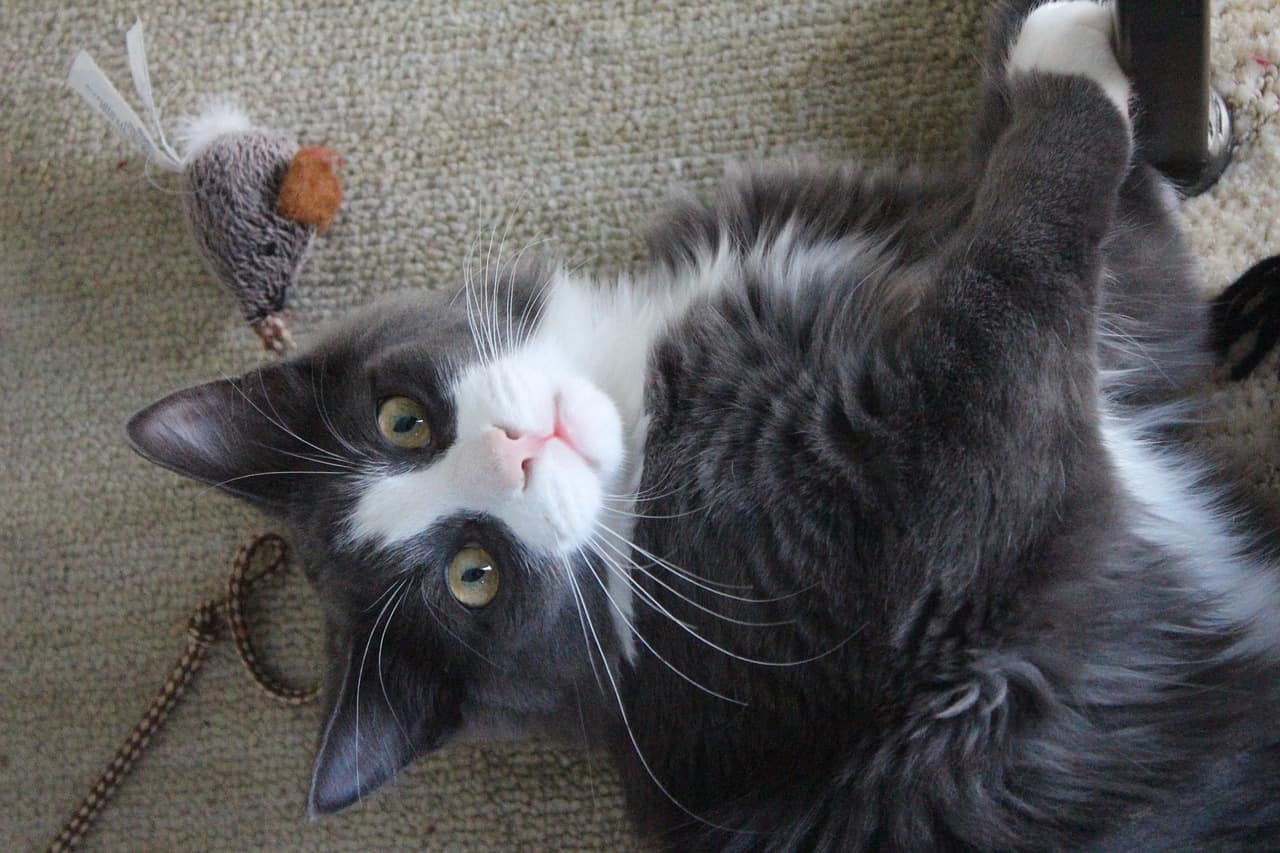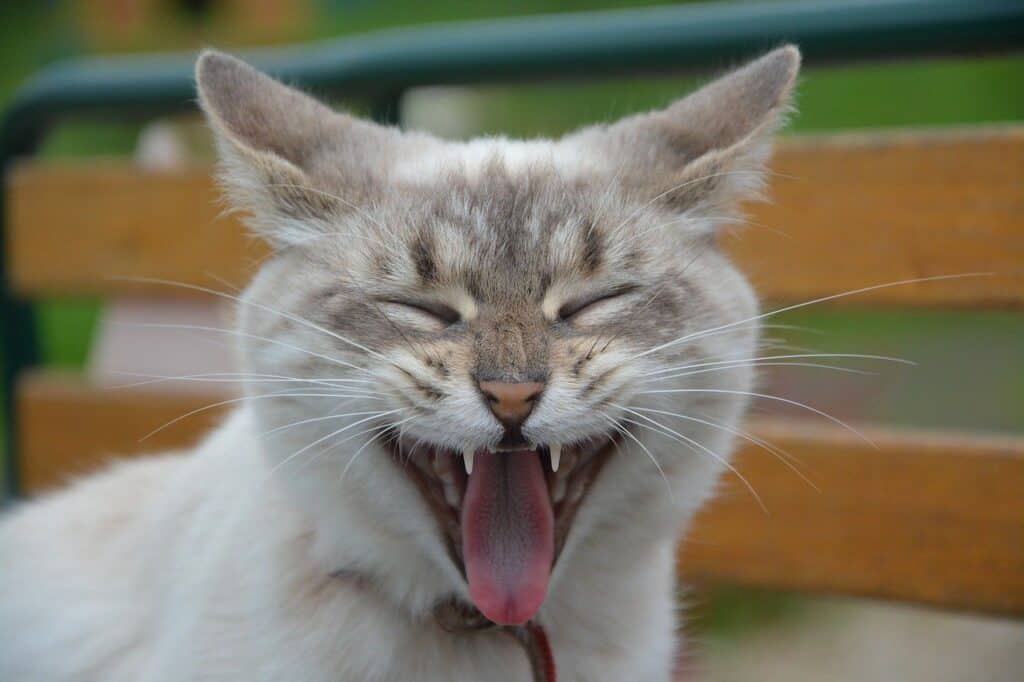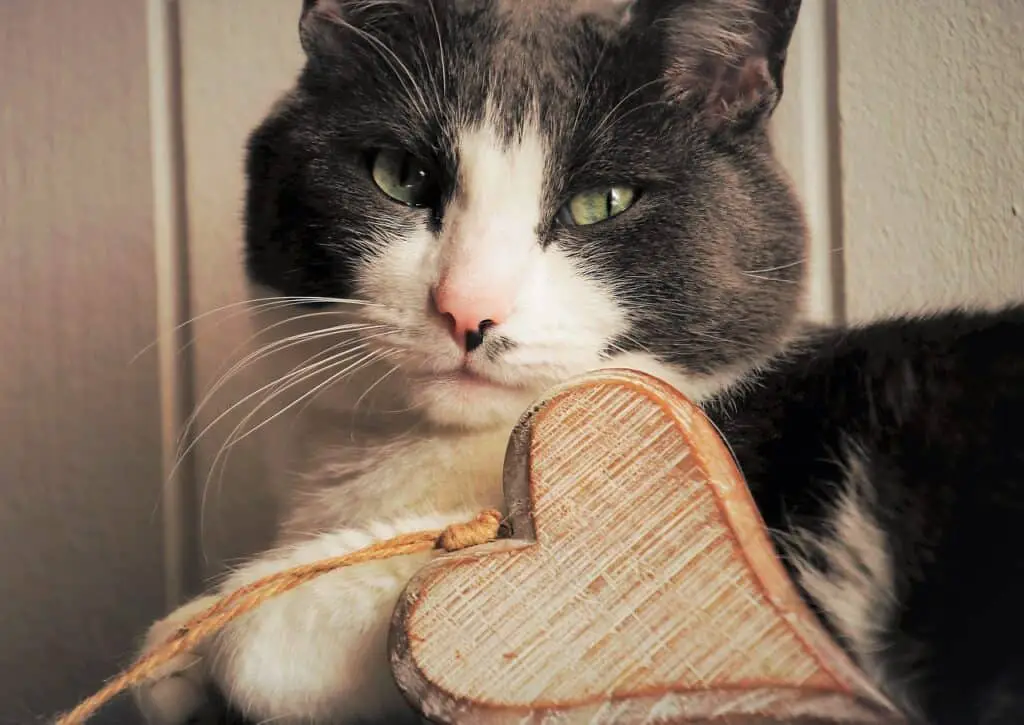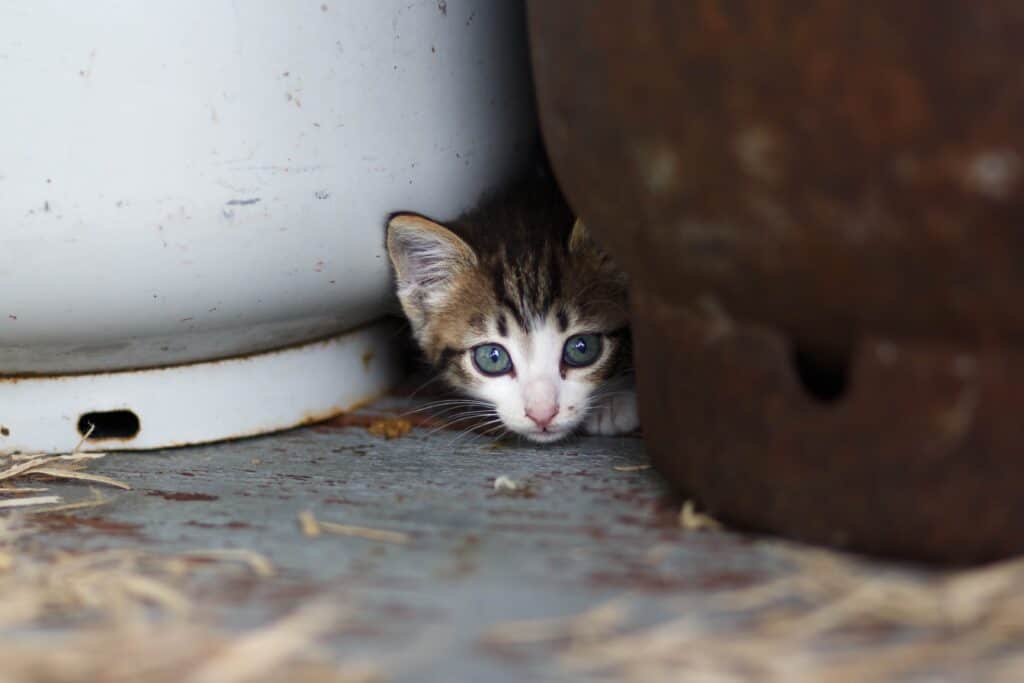Some people see cats as these grumpy creatures who only care about sleeping and eating, but the reality is different.
Believe it or not, cats love to play a lot, and not just when they’re kittens. But cats are complicated creatures, and sometimes humans need a little help in understanding how your fluffy wants to be played with.
Playing fulfills an essential role in a cat’s life
Cats need to play to satisfy their social needs, release stress, and maintain their mental health. Kittens are more playful than adult cats, but cats of all ages benefit from regular play sessions. To entice your cat to play, create a welcoming environment, use the correct toys, play the appropriate games.
In short, understand your cat’s personal needs when it comes to playing.
Regular playing with your cat will help create a strong bond between the two of you. And it will also reduce unwanted or aggressive behaviors like scratching or biting.
No wonder it’s one of the cats’ most favorite things to do.
Why is play important to cats?
It’s not just dogs who need constant attention; cats need it too! But unlike dogs, cats have different playing needs that you should be aware of if you want to have a successful play session.
Let’s further look into why playing is so important for cats.
Play is not only important but even necessary for cats. Some cat parents believe play is a way for kittens to learn hunting skills, but it’s more than just that.
Playing stimulates a cat’s hunting instincts, and it can be an essential factor in the games that cats like to play, However,…
Playing is essential in building relationships among cats, releasing stress, and having fun. It helps reinforce bonds and maintain a healthy mental state.
Play as a social mechanism
One study suggests that social play among kittens provides specific forms of exercise and serves as a way to develop and maintain social relationships among littermates.
Researchers also noticed how kittens without littermates tend to be socially awkward, like that strange kid who doesn’t know how to interact with the other children.
Kittens without littermates will always direct their playing needs to others. This can be the mother, other cats in the vicinity, or their human cat parent in many cases.
Sometimes fresh cat owners who adopt single kitten report constantly getting scratched from this playful behavior. That’s one of the reasons why it’s often better to adopt a pair from the same litter.
Playing helps to release stress and reduce negative behaviors!
You would think a cat’s life is a stress-free adventure, right? No work, no school, just meow meow.
But cats can get stressed for various reasons, especially indoor cats. Well-known triggers for cat stress are, for example, loud noises, a lack of privacy, dirty litterboxes, or introducing unknown elements into their territory.
Playing is a necessity for stressed cats. It helps them release energy, use their claws, and feel like they’ve accomplished something. And If they can’t release this playful energy during play sessions, they’ll find other methods such as couch scratching and bitting.
So if you regularly cope with an aggressive cat, the chances are that it is stress getting the better of them and they need a way to release. There’s a good chance that regular playtime and some cat games will solve these issues.
What happens if you don’t play with your cat?
On the most extreme side of the spectrum, never playing with your cat can negatively affect its wellbeing.
- The first months are vital to developing social skills through play for kittens. If you have a single kitten and take away play sessions, your kitten will be missing a crucial period of socialization. The result is a cat who may not like to be touched and doesn’t know how to redirect play energy.
- For adults cats, not having play sessions can make them prone to sedentarism plus the (mental) health problems associated with a sedentary lifestyle. Since playing helps cats release stress and energy, not playing can make them prone to undesired behaviors and depression, anxiety, and aggression.
- Senior cats benefit from play as it helps them work on mobility and mental agility. Slow games or games where they don’t have to move too much are ideal for senior cats. Not playing with senior cats makes them prone to physical and mental issues.
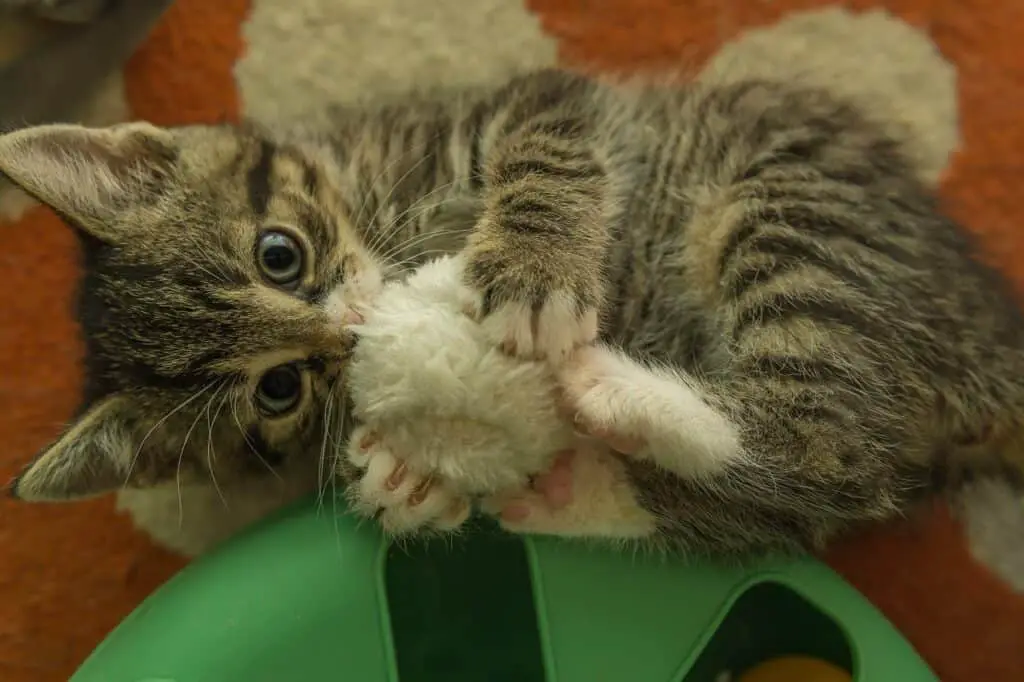
How can I play with my indoor cat?
Playing with your indoor cat can be a fun family activity. As long as you understand your cat’s needs and personality, It’ll be great.
Here are some considerations to optimize your play sessions with your cat:
Create a playful environment
Creating a playful environment is the best way to promote playing in cats. Getting a scratching post plus a few empty cardboard boxes next to it is something they’ll love. If you need to leave the house for a few hours, a playful environment can keep your cats entertained while you’re away.
Scatch posts come in many shapes and sizes, and chances are your cat will have a preference for one over the other. I have tried about three different kinds for my cat, Max, until I found the one he likes best.
I’d suggest looking at what Amazon has to offer since it’ll be easy to return and try something else if your feline friend doesn’t like it.
I’ve selected a few choices here.
Apart from having the right gear, make sure you give your cat some room to play. Cats enjoy physical games like running around, jumping, and sliding. To avoid her bumping into your priceless family heirlooms, keep those at a distance and make room for play.
It’s also a good idea to create a safe playing environment. Remove any dangerous or sharp objects and loose power cables.
Know when it’s time to play
Don’t push your cat to play. You can try to initiate play sessions by presenting toys to your cat, but if you see no response, it means it’s not time. Forcing your cat to play will just make your cat feel annoyed, unsafe and you’ll achieve the opposite of what’s intended; a good time with your cat.
Take time with your cats
If you have more than one cat in your household, take the time to play with them individually. While you might feel tempted to play with all your cats at once to save time, this isn’t an effective strategy.
One-on-one attention really builds that relationship between you and your cat.
Individual cats have different preferences, so while a cat might like a mouse toy, another cat can prefer a ping pong ball or a piece of string.
Each cat may also have preferences for the duration and intensity of play sessions, so taking time to address them individually it’s the best.
Play games that mimic prey
Biologically speaking, cats are carnivore predators. They still carry some wild traits inside them, so if you can get your cat to feel like it’s hunting prey, you’ll be great.
Toys with feathers, bright colors, and fuzzy sounds are going to capture your cat’s attention in a second. Fishing rods and balls can be entertaining too. So, anything that moves and screams: “come get me.”
Some cats like brain games that entice them to figure something out, like how to get an (imaginary) prey out of a hiding spot.
Here’s an example that stimulates hunting and thinking and gives a reward when your cat successfully achieves the task (check the price on Amazon).

Have different toys!
According to cat experts and solid research, cats get bored of their toys. So if you want to keep play sessions running, you need to get more than just one toy.
Try using feathered toys and then using balls. You can even have the same toy but different colors to catch your cat’s attention.
Stay during play sessions
Cats can seem like the ideal pets for busy people. Cats clean themselves, they rarely need you, plus they don’t require too much attention.
That’s just not true, cats LOVE our attention, and they really enjoy playing together. Just leaving toys on the floor for your cat to play with isn’t going to help much.
Make playtime a bonding event. Apart from having fun together, it helps build or improve your relationship with your cat. Even only 20 minutes per day will do wonders and keeps your cat healthy.
Your cat should catch the prey
Every cat owner needs to hear this:
Because a cat’s playful behavior is based on its hunter’s instinct. It is ESSENTIAL for your cat to “catch” the prey in the end. There needs to be a reward at the end of the playing session.
Let your cat catch the toy, the piece of string, or whatever you play with to give your cat a sense of accomplishment. It is at this moment that your cat feels it is rewarded.
What happens if your cat doesn’t catch the toy? Well, it can become a stressful moment for your cat instead of a fun play session.
For this reason, experts generally don’t recommend playing with your cat using laser pointers or cat apps. Not being able to catch something can annoy them and trigger stress.
If you have to use a laser pointer, make sure you give your cat a treat when it “catches” the laser.
Always take toys away after using them!
Once you’re all ready to move on from a playing session, always take the toys away. Mainly because you don’t want your cat to play unsupervised, but also because they’ll get bored of them.
Not seeing the toys can make your cat feel excited for them. Then, when you take them out, it’s like they’re getting a new toy, and it signals to them that playtime has started.
Play for kittens
The best thing you can do for a kitten is let it play with its littermates. Kittens are active and playful during the first months of life because it’s their way to explore and socialize. If you’re thinking about getting a kitten, it’s a great idea to adopt it with a littermate so they can both play.
Kittens are super-playful, so play sessions are typically more frequent and last longer. During this time, it’s the perfect moment to teach your kitten about play boundaries and rules, so keep that in mind.
Play for senior cats
Unlike kittens, senior cats aren’t as active and fast as they once were. Several issues may arise with age.
Cats may suffer hearing loss, blindness, arthritis, and more. But still, playing is good for them; it keeps them fit, both mentally and physically.
So how do you play with senior cats?
When playing with senior cats, it is important to understand their limitations. Older cats may not move as fast as the younger ones, so often, brain games are more suitable for older cats. When using toys, choose the softer ones, and they can grab easily.
Toys filled with catnip are often favorites of all cats but especially for seniors. I’ve selected my Max’s favorite catnip toy below (check price on Amazon)

Can my cat’s personality affect playtime?
If you’ve owned more than one cat in your lifetime, you know that no two cats are the same. Some cats are naturally energetic, others are shyer, and others love affection. Having this in mind, it’s good to consider your cat’s personal preferences and personality before you begin playing with it.
Cats can have preferences over toys too. Try to figure out which toys your cat prefers by trying out different toys. Consider the following aspects:
- Size.
- Shape.
- Color.
- Smell.
- Noise.
- Texture.
- Softness.
Your cat may lean towards some toys more than others, so it’s always a great idea to try out different toys.
How do I know my cat wants to play?
In short, by observing your cat’s behavior and personality.
Some cats are naturally playful and will show signs of availability. They can start vocalizing, spontaneously play with objects, have crouched legs, and more.
Other cats won’t show that much excitement about playing, so you’ll have to suggest play and see how they react.
And, if you initiate a playing session and your cat shows no interest, let it go and try later. It might not be the right time.
What toys do cats like?
Cats prefer toys with a lot of mobility because it reminds them of prey. So you have to stay with them and move the toy to get your cat’s attention.
Below are some of my personal recommendations that I’ve either got for my own cats or which cats in my family enjoy…
- Tall scratching posts: It allows to explore up high and stretch its claws.

- Balls: Small, medium-sized, or large balls can entertain cats of all ages. Ping pong balls do the trick, but balls with bells inside them offer a great auditory stimulus.

- Fishing rod: Cats love toys that look like fishing rods with prey at the end. It gives you control over the session. You can play together and make your cat chase and jump as it tries to catch the prey.

- Catnip toys: Catnip is a herb that makes cats playful around it. However, not all cats react the same to catnip, some might not even bother, and some become aggressive. It’s best to see how your cat reacts to catnip first and then decide if it’s okay to keep using it.

- Soft toys: Some cats prefer soft toys that look like small animals. Especially senior cats, who might need a toy to feel comfortable.

- Food puzzles: With a food puzzle, your cat has to work to get a treat. Cats are intelligent animals, and a food puzzle is a great way to keep them mentally agile.

- Home-made toys: Toys made out of things in your house like aluminum foil balls, cardboard boxes, and paper bags (never plastic bags) are okay too. Always watch your cat while playing you’re playing together.
What’s the best time to play with my cat?
The best time to play with your cat will depend on your cat!
Some cats get more playful at night or before eating. But other cats can be playful when they see you coming home or as soon as you wake up.
Many cat parents experience their cat’s “Crazy Hour”. It’s different for each cat, and especially with kittens or junior cats, they will show you when they’re in the mood to play.
The best time to play with your cat is when your cat shows a willingness to play.
How long do play sessions with my cat should last?
Typically, play sessions are short and will last about 10-20 minutes each. Ideally speaking, you’d have several play sessions throughout the day. Two to four play sessions will be enough, but again, it all depends on your cat’s personality and age.
How not to play with your cat
Playing is great, and most of the time, cats are careful not to hurt themselves; however, same as with kids, it’s good to keep safety in mind.
Always use cat-safe toys
Try to minimize problems by using cat-safe toys. Strings, rubber bands, ribbons, and loose parts can be dangerous for cats because they can get tangled in them or swallow them.
Is it okay to play with your cat using your hand?
Many cat owners can wonder if it’s okay to let your cat bite you. The answer is a big no!
It would be best if you never let your cat play with your hands or toes. That’s because you’re teaching your cat that it’s okay to bite or scratch you. Remember that cats learn through play, so educate your cat to play with toys only.
Even the mother will also teach them not to bite her during play. She can get quite aggressive with them if they bite her tail or ears. That is how kittens learn, and it’s good to teach them that biting is not OK.
What should I do if my cat becomes aggressive while playing?
If your cat becomes too aggressive during play sessions, it’s best to end it. Teach your cat that aggressive behaviors aren’t okay during play.

